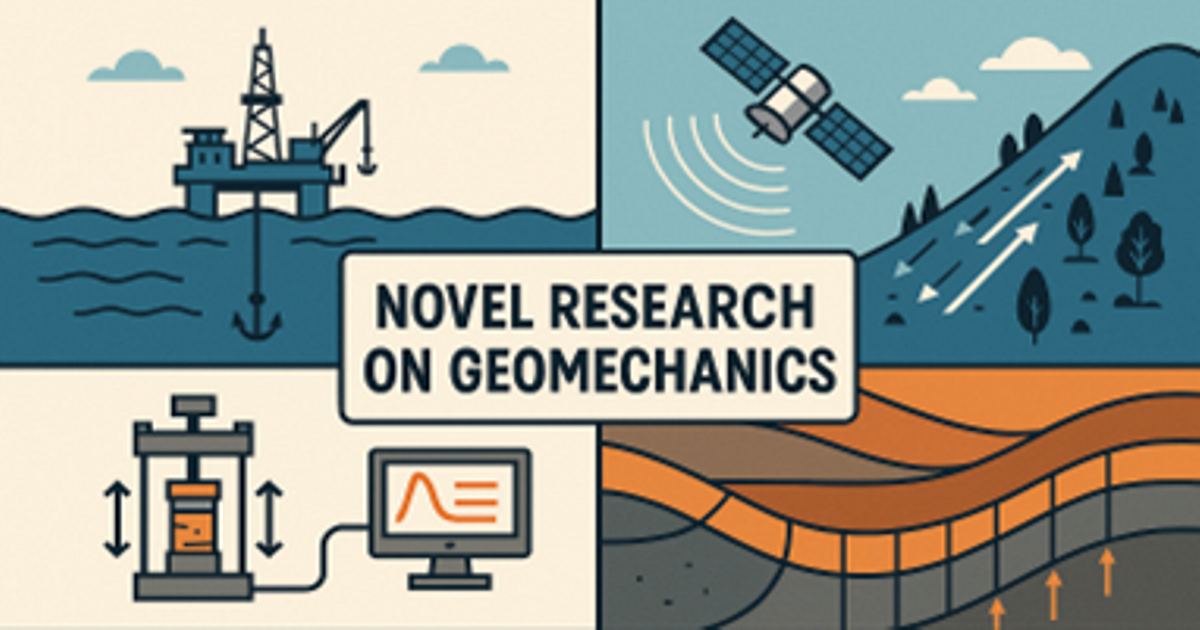Novel Research on Geomechanics: Current Status and Future Challenges
A special issue of Applied Sciences (ISSN 2076-3417). This special issue belongs to the section "Civil Engineering".
Deadline for manuscript submissions: 10 April 2026 | Viewed by 180

Special Issue Editors
Interests: computational geomechanics; geotechnical engineering
Interests: landslide risk analysis; InSAR; artificial intelligence; landslide early earning and prediction
Special Issues, Collections and Topics in MDPI journals
Special Issue Information
Dear Colleagues,
The escalating global demand for energy has driven the rapid development of large-scale infrastructures, where extreme environments such as deep sea, underground space, and outer space pose significant challenges for ensuring safe design, efficient operation, and long-term performance. Geomechanics is evolving rapidly, integrating advanced testing, numerical modeling, and monitoring techniques across multiple spatial and temporal scales to investigate the evolutionary behavior of geomaterials and structures, thereby enhancing our ability to understand and predict their responses in diverse engineering applications. The integration of advanced techniques—including laboratory testing, high-resolution monitoring, and computational modeling—becomes increasingly critical as the rising frequency and intensity of extreme climate events significantly amplify geohazard risks, such as landslides, slope failures, subsidence, and offshore instabilities.
This special issue welcomes high-quality contributions presenting innovative theories, methods, devices, and applications that advance geomechanics, covering fundamental mechanisms, emerging techniques, and engineering applications. Topics of interest include, but are not limited to:
- Advanced numerical and computational methods for coupled multi-physics processes
- InSAR-based monitoring and high-resolution techniques for geohazard detection and early warning
- Novel experimental techniques and multi-scale characterization of geomaterials
- Offshore and subsea geotechnical engineering problems, including soil–structure interaction and hydrate-related issues
- Slope stability, landslide dynamics, and hazard mitigation strategies under extreme climatic and geological conditions
- Energy geotechnics, including subsurface energy storage, energy piles, and thermo-hydro-mechanical coupling
This special issue aims to provide a platform for sharing cutting-edge research and fostering cross-disciplinary collaboration to advance geomechanics and promote sustainable, resilient engineering solutions.
Dr. Liang Wang
Dr. Chao Zhou
Guest Editors
Manuscript Submission Information
Manuscripts should be submitted online at www.mdpi.com by registering and logging in to this website. Once you are registered, click here to go to the submission form. Manuscripts can be submitted until the deadline. All submissions that pass pre-check are peer-reviewed. Accepted papers will be published continuously in the journal (as soon as accepted) and will be listed together on the special issue website. Research articles, review articles as well as short communications are invited. For planned papers, a title and short abstract (about 250 words) can be sent to the Editorial Office for assessment.
Submitted manuscripts should not have been published previously, nor be under consideration for publication elsewhere (except conference proceedings papers). All manuscripts are thoroughly refereed through a single-blind peer-review process. A guide for authors and other relevant information for submission of manuscripts is available on the Instructions for Authors page. Applied Sciences is an international peer-reviewed open access semimonthly journal published by MDPI.
Please visit the Instructions for Authors page before submitting a manuscript. The Article Processing Charge (APC) for publication in this open access journal is 2400 CHF (Swiss Francs). Submitted papers should be well formatted and use good English. Authors may use MDPI's English editing service prior to publication or during author revisions.
Keywords
- numerical methods
- geotechnical stability analysis
- early warning system
- monitoring
- experimental rock mechanics
- natural hazards
- offshore geotechnics
- soil mechanics
- energy geotechnics
- artificial intelligence
Benefits of Publishing in a Special Issue
- Ease of navigation: Grouping papers by topic helps scholars navigate broad scope journals more efficiently.
- Greater discoverability: Special Issues support the reach and impact of scientific research. Articles in Special Issues are more discoverable and cited more frequently.
- Expansion of research network: Special Issues facilitate connections among authors, fostering scientific collaborations.
- External promotion: Articles in Special Issues are often promoted through the journal's social media, increasing their visibility.
- Reprint: MDPI Books provides the opportunity to republish successful Special Issues in book format, both online and in print.
Further information on MDPI's Special Issue policies can be found here.






